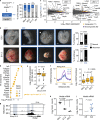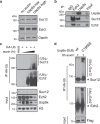The deubiquitinase Usp9x regulates PRC2-mediated chromatin reprogramming during mouse development
- PMID: 33767158
- PMCID: PMC7994559
- DOI: 10.1038/s41467-021-21910-0
The deubiquitinase Usp9x regulates PRC2-mediated chromatin reprogramming during mouse development
Abstract
Pluripotent cells of the mammalian embryo undergo extensive chromatin rewiring to prepare for lineage commitment after implantation. Repressive H3K27me3, deposited by Polycomb Repressive Complex 2 (PRC2), is reallocated from large blankets in pre-implantation embryos to mark promoters of developmental genes. The regulation of this global redistribution of H3K27me3 is poorly understood. Here we report a post-translational mechanism that destabilizes PRC2 to constrict H3K27me3 during lineage commitment. Using an auxin-inducible degron system, we show that the deubiquitinase Usp9x is required for mouse embryonic stem (ES) cell self-renewal. Usp9x-high ES cells have high PRC2 levels and bear a chromatin and transcriptional signature of the pre-implantation embryo, whereas Usp9x-low ES cells resemble the post-implantation, gastrulating epiblast. We show that Usp9x interacts with, deubiquitinates and stabilizes PRC2. Deletion of Usp9x in post-implantation embryos results in the derepression of genes that normally gain H3K27me3 after gastrulation, followed by the appearance of morphological abnormalities at E9.5, pointing to a recurrent link between Usp9x and PRC2 during development. Usp9x is a marker of "stemness" and is mutated in various neurological disorders and cancers. Our results unveil a Usp9x-PRC2 regulatory axis that is critical at peri-implantation and may be redeployed in other stem cell fate transitions and disease states.
Conflict of interest statement
The authors declare no competing interests.
Figures





Similar articles
-
Integrative Proteomic Profiling Reveals PRC2-Dependent Epigenetic Crosstalk Maintains Ground-State Pluripotency.Cell Stem Cell. 2019 Jan 3;24(1):123-137.e8. doi: 10.1016/j.stem.2018.10.017. Epub 2018 Nov 21. Cell Stem Cell. 2019. PMID: 30472157
-
DEAD-Box Helicase 18 Counteracts PRC2 to Safeguard Ribosomal DNA in Pluripotency Regulation.Cell Rep. 2020 Jan 7;30(1):81-97.e7. doi: 10.1016/j.celrep.2019.12.021. Cell Rep. 2020. PMID: 31914400
-
EPOP Functionally Links Elongin and Polycomb in Pluripotent Stem Cells.Mol Cell. 2016 Nov 17;64(4):645-658. doi: 10.1016/j.molcel.2016.10.018. Mol Cell. 2016. PMID: 27863225
-
Not just a writer: PRC2 as a chromatin reader.Biochem Soc Trans. 2021 Jun 30;49(3):1159-1170. doi: 10.1042/BST20200728. Biochem Soc Trans. 2021. PMID: 34060617 Free PMC article. Review.
-
A Structural Perspective on Gene Repression by Polycomb Repressive Complex 2.Subcell Biochem. 2021;96:519-562. doi: 10.1007/978-3-030-58971-4_17. Subcell Biochem. 2021. PMID: 33252743 Review.
Cited by
-
Gender-specific genetic and epigenetic signatures in cardiovascular disease.Front Cardiovasc Med. 2024 Mar 11;11:1355980. doi: 10.3389/fcvm.2024.1355980. eCollection 2024. Front Cardiovasc Med. 2024. PMID: 38529333 Free PMC article. Review.
-
20 years of stemness: From stem cells to hypertranscription and back.Stem Cell Reports. 2025 Mar 11;20(3):102406. doi: 10.1016/j.stemcr.2025.102406. Epub 2025 Feb 6. Stem Cell Reports. 2025. PMID: 39919752 Free PMC article. Review.
-
m 6 A RNA methylation orchestrates transcriptional dormancy during developmental pausing.bioRxiv [Preprint]. 2023 Feb 1:2023.01.30.526234. doi: 10.1101/2023.01.30.526234. bioRxiv. 2023. Update in: Nat Cell Biol. 2023 Sep;25(9):1279-1289. doi: 10.1038/s41556-023-01212-x. PMID: 36778216 Free PMC article. Updated. Preprint.
-
Deubiquitinases in cell death and inflammation.Biochem J. 2022 May 27;479(10):1103-1119. doi: 10.1042/BCJ20210735. Biochem J. 2022. PMID: 35608338 Free PMC article. Review.
-
H3K27me3-mediated epigenetic regulation in pluripotency maintenance and lineage differentiation.Cell Insight. 2024 Jun 27;3(4):100180. doi: 10.1016/j.cellin.2024.100180. eCollection 2024 Aug. Cell Insight. 2024. PMID: 39072246 Free PMC article. Review.
References
Publication types
MeSH terms
Substances
Grants and funding
LinkOut - more resources
Full Text Sources
Other Literature Sources
Molecular Biology Databases
Research Materials

